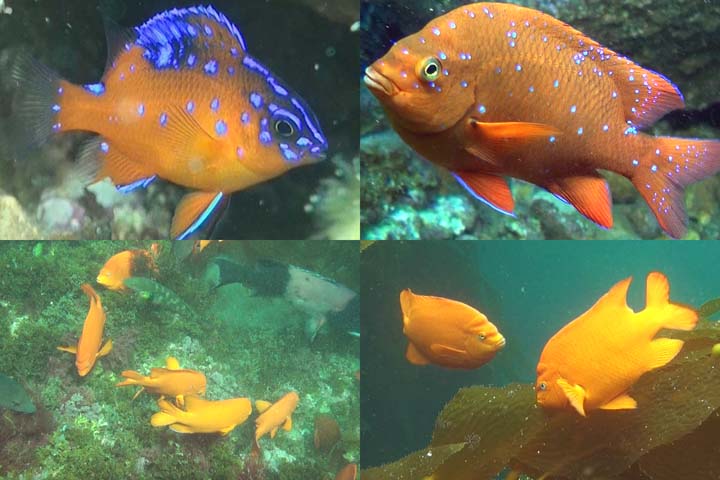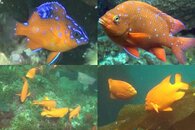DIVE DRY WITH DR. BILL #502: PRETTY "BABES" ALL IN A ROW
Recently I wrote about the thrilling sexcapades of my frequent dive buddy, Gary Garibaldi. He and his brothers and sisters indulge in prolific procreation during months when the water temperature rises above 58 F. During this period of heightened hormones, Gary and his brothers actively defend their nests against all intruders... including yours truly! An unobservant diver may get their fins nipped or their fingers bitten if they venture too close!
But all good things eventually come to an end. Gary essentially abandons his nest and without the constant care and gardening, "weeds" (other algae) invade the nests once dominated by the brilliant red algae. The nests begin to look like the lawns of foreclosed homes across the country. But are the garibaldi sad like those former homeowners? Heck no, they celebrate. No longer required to defend their nests against even their siblings, the garibaldi exhibit a different form of "love fest." Their parental care is over for the year and they quickly enjoy the life of the "empty nester." They freely gather in large groups without need for aggression. They wander away from their reef-based territories and head up into the kelp canopy where they pick delicacies off the kelp blades while pursuing that other "M" word, munching.
No, the "kids" haven't gone off to college or gotten jobs. When the eggs hatch shortly after sunset, the tiny larvae rise towards the light of the moon and begin a period of drift in the plankton. Once they tire of seeing the world, they settle ("recruit") to the reefs between July and November. At this stage they are tiny (less than an inch). Dr. Milton Love says that these youngsters may form small schools initially and then "go their own way." Almost all the tiny tots I've seen in the dive park are by their lonesome, although on occasion I've seen two, three and even four in the same general area. I've also noted what appears to be aggression between them when they are in such close quarters.
Now adult garibaldi are a beautiful sight in our temperate kelp forests. Their bright orange color almost makes a person think they are diving tropical waters, at least until the shivers begin! However, they don't hold a candle to the incredible colors of their youngsters. When they grow and reach the lower threshold of my failing vision, baby garibaldi are a nearly fluorescent blue and orange. If these fish were as large as their parents, they would undoubtedly be considered the most beautiful residents of our waters. However, their tiny size does make them less obvious to most.
As they age, the garibaldi lose much of the fluorescent blue coloring. It gradually recedes to numerous bright blue spots on the orange body making the older babies look like they have Martian measles. It has long been said that the blue in their coloration serves as a signal to the adult garibaldi that these are just kids and they pose no threat to their parents, aunts and uncles who are guarding their territories. However, I frequently observe adults chasing the youngsters away despite this assumption by scientists and divers. Of course we all know how kids can irritate their parents on occasion (well, except for my son Kevin... he's just about perfect!).
When diving in the dive park in late summer, two things I always keep an eye out for are the tiny baby garibaldi... and the giant giant sea bass. Quite a contrast in size, but both make wonderful subjects to film. Of course there is less technical skill involved in filming giant sea bass... as long as you can find them and they remain still long enough to capture on camera. The tiny garibaldi are a different story. They flit around like they are very nervous (anthropomorphic, I know), making them hard to keep in the viewfinder frame. Their tiny size makes it difficult to focus sharply on them, and when I review the day's footage they are often blurry and the rocks in the background in sharp focus.
Because the baby garibaldi are so small, they don't require a lot of space for their territories. In some areas of the dive park, I see one every few feet in the shallow depths above 20 ft. I can spend a few dives just moving from one to the other trying to get that perfect footage for future videos. Pretty soon I plan to head over to the mainland to visit my special "baby," granddaughter Allison. Son Kevin and his wife Mary have another one (Erin) on the way... pretty babies all in a row just like the garibaldi!
Image caption: Tiny baby and later juvenile; "empty nester" adults gathering together and feeding in kelp canopy.

Recently I wrote about the thrilling sexcapades of my frequent dive buddy, Gary Garibaldi. He and his brothers and sisters indulge in prolific procreation during months when the water temperature rises above 58 F. During this period of heightened hormones, Gary and his brothers actively defend their nests against all intruders... including yours truly! An unobservant diver may get their fins nipped or their fingers bitten if they venture too close!
But all good things eventually come to an end. Gary essentially abandons his nest and without the constant care and gardening, "weeds" (other algae) invade the nests once dominated by the brilliant red algae. The nests begin to look like the lawns of foreclosed homes across the country. But are the garibaldi sad like those former homeowners? Heck no, they celebrate. No longer required to defend their nests against even their siblings, the garibaldi exhibit a different form of "love fest." Their parental care is over for the year and they quickly enjoy the life of the "empty nester." They freely gather in large groups without need for aggression. They wander away from their reef-based territories and head up into the kelp canopy where they pick delicacies off the kelp blades while pursuing that other "M" word, munching.
No, the "kids" haven't gone off to college or gotten jobs. When the eggs hatch shortly after sunset, the tiny larvae rise towards the light of the moon and begin a period of drift in the plankton. Once they tire of seeing the world, they settle ("recruit") to the reefs between July and November. At this stage they are tiny (less than an inch). Dr. Milton Love says that these youngsters may form small schools initially and then "go their own way." Almost all the tiny tots I've seen in the dive park are by their lonesome, although on occasion I've seen two, three and even four in the same general area. I've also noted what appears to be aggression between them when they are in such close quarters.
Now adult garibaldi are a beautiful sight in our temperate kelp forests. Their bright orange color almost makes a person think they are diving tropical waters, at least until the shivers begin! However, they don't hold a candle to the incredible colors of their youngsters. When they grow and reach the lower threshold of my failing vision, baby garibaldi are a nearly fluorescent blue and orange. If these fish were as large as their parents, they would undoubtedly be considered the most beautiful residents of our waters. However, their tiny size does make them less obvious to most.
As they age, the garibaldi lose much of the fluorescent blue coloring. It gradually recedes to numerous bright blue spots on the orange body making the older babies look like they have Martian measles. It has long been said that the blue in their coloration serves as a signal to the adult garibaldi that these are just kids and they pose no threat to their parents, aunts and uncles who are guarding their territories. However, I frequently observe adults chasing the youngsters away despite this assumption by scientists and divers. Of course we all know how kids can irritate their parents on occasion (well, except for my son Kevin... he's just about perfect!).
When diving in the dive park in late summer, two things I always keep an eye out for are the tiny baby garibaldi... and the giant giant sea bass. Quite a contrast in size, but both make wonderful subjects to film. Of course there is less technical skill involved in filming giant sea bass... as long as you can find them and they remain still long enough to capture on camera. The tiny garibaldi are a different story. They flit around like they are very nervous (anthropomorphic, I know), making them hard to keep in the viewfinder frame. Their tiny size makes it difficult to focus sharply on them, and when I review the day's footage they are often blurry and the rocks in the background in sharp focus.
Because the baby garibaldi are so small, they don't require a lot of space for their territories. In some areas of the dive park, I see one every few feet in the shallow depths above 20 ft. I can spend a few dives just moving from one to the other trying to get that perfect footage for future videos. Pretty soon I plan to head over to the mainland to visit my special "baby," granddaughter Allison. Son Kevin and his wife Mary have another one (Erin) on the way... pretty babies all in a row just like the garibaldi!
Image caption: Tiny baby and later juvenile; "empty nester" adults gathering together and feeding in kelp canopy.






